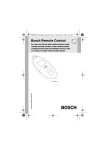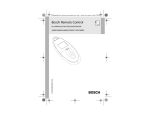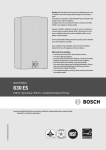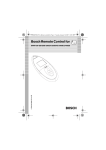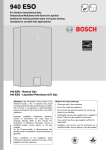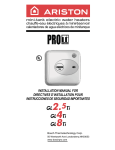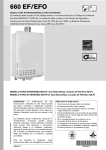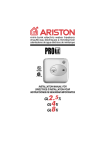Download Bosch 2400E NG Installation manual
Transcript
Installation Instructions Gas Conversion Kit For models: 250 SX, 250 SXO, GWH 2400 E, GWH 2400 EO, GWH 635 ES, GWH 635 ESO, GWH 715ES, GWH 2700 ES, GWH 2400 ES, Evolution 500, 830ES, 940ES, 940ESO Part. no 8 719 002 176 6 720 607 679 (2009/05) US Warning: This kit shall be installed by a qualified service agency in accordance with these instructions and all applicable codes and requirements of the authorities having jurisdiction. Gas Type Conversion 1 Gas Type Conversion For models: 250SX, 250SXO, GWH 635 ES, GWH 635 ESO, GWH 2400 E, GWH 2400 EO only LP AND NG ARE EXTEMELY FLAMMABLE SO TAKE EXTRA PRECAUTIONS WHEN PERFORMING ANY WORK TO THE HEATER. i PROCEDURE MUST BE PERFORMED BY A LICENSED GAS TECHNICIAN. Fig. 2 A. Preparation B 7. Remove yellow painted # 40 Torx cover from the front of the gas valve revealing a plastic #40 Torx screw (Fig. 3). B 1. Tools needed: – flat and Phillips screwdrivers – #40 Torx driver – digital combustion analyzer B 2. Turn power switch to off position and unplug water heater. B 3. Remove cover. B 4. Remove control board access cover (Fig. 1). Fig. 3 2 SCREWS TO REMOVE Fig. 1 B 5. Remove lower wire harness from control board. B 6. Loosen yellow painted Philips screw and cover should rotate down revealing a brass slotted screw (Fig. 2). 2 6 720 607 679 Gas Type Conversion B. Converting from LPG to NG B 1. Add jumper to location JP6 on the control board (Fig. 4). 6720607679-11.1AL Fig. 4 B 2. Turn slotted brass screw 3.5 turns counter clockwise (Fig. 2). B 3. Turn #40 plastic torx screw 1 tooth clockwise (Fig. 3). B 4. Adjust CO2 (see chapter 2). C. Converting from NG to LPG B 1. remove jumper from location JP6 on the control board (Fig. 4). B 2. Turn slotted brass screw 3.5 turns clockwise (Fig. 2). B 3. Turn #40 plastic torx screw 1 tooth counter clockwise (Fig. 3). B 4. Adjust CO2 (see chapter 2). D. Clean up B 1. Reinstall yellow painted #40 Torx cover on the front of gas valve (Fig. 3). B 2. Rotate brass slotted screw cover up and tighten yellow painted Philips screw (Fig. 2). B 3. Reinstall lower wire harness onto control board. B 4. Reinstall control board access cover (Fig. 1). B 5. Apply conversion sticker to right side panel above rating plate. Ensure information is filled out accurately. B 6. Reinstall cover and return to service. 6 720 607 679 3 Measuring and adjusting CO2 levels 2 Measuring and adjusting CO2 levels The CO2 can only be adjusted by a certified gas technician with a calibrated CO2 analyzer. Caution: One factor that may affect CO2 levels is improper gas pressure. Please see Chapter 2.12 of manual for the procedure to measure gas pressure and record your findings below: Static Gas Pressure: " WC P1 Operating Pressure: " WC The P1 minimum operating pressure is 5" WC for Natural Gas and 11"WC for Propane. Do not proceed in adjusting CO2 until pressure is at or above these levels, but not to exceed 14” WC. A. Once Pressure is adequate B Turn ON/OFF switch to the OFF (O) position. B Remove brass flat head screw on the exhaust collar, see Fig. 5. B Insert CO2 analyzer probe into the measuring port. Avoid air gaps between probe and measuring port. The tip of the probe should be in the center of the flue pipe (approx 1.5" inserted). B. Measuring CO2 (Cover Installed): B Open hot water taps to achieve a flow rate of at least 4 gallons per minute. (1 tub and 2 sinks should be sufficient). B Record the CO2 reading in P2 below. (Analyzer reading may take several minutes to stabilize). B Press the ‘+’ button until P1 appears. Unit will ramp up to high fire and the water flow should increase. B Record the CO2 reading in P1 below. P2 CO2 Reading: % CO2 P1 CO2 Reading: % CO2 Compare your readings to those found in table 1 under the “With Front Cover” column. If CO2 readings are off make adjustments as outlined below. Note: The “Without Front Cover” column give approximate values with the cover off to ease the adjustment process. Final readings should be taken with the cover on. C. Adjusting CO2: Note: P1 adjustment will change the P2 reading. Confirm the P1 value BEFORE adjusting the P2 level. 1. P1 CO2 level adjustment: B Loosen yellow painted Philips screw (1) and rotate cover down (2) revealing a brass slotted screw. Fig. 7. B Adjusting the slotted screw counter clockwise will raise P1 CO2 levels and clockwise will lower P1 CO2 levels. Adjustments to the slotted screw will also change P2 CO2 levels. 2. P2 CO2 level adjustment: B Remove yellow painted #40 Torx cover from the front of the gas valve. (Fig. 8) A plastic #40 Torx screw will be revealed. Fig. 5 B While holding in the Program (P) button, turn the ON/OFF switch to ON (I) position (see Fig. 6). As soon as ‘188’ flashes on the display, release the Program button. The display should now read P2. B Adjusting the plastic #40 Torx screw counter clockwise will lower P2 CO2 levels and clockwise will raise P2 CO2 levels. Note: This screw adjustment is very sensitive and may take several minutes to stabilize. 3. Verify both P1 and P2 are within the ranges specified in table 1 under the “With Front Cover” column. Repeat steps 1 and 2 as necesssary until CO2 values are within the specified ranges. Fig. 6 4 6 720 607 679 Measuring and adjusting CO2 levels D. Returning to Service: 1. Return slotted cover to original position. 2. Reinstall Torx cover. 3. Remove CO2 analyzer probe and reinstall flathead screw with gasket in exhaust collar. 4. Turn ON/OFF switch to the OFF (O) position and then back to the ON (I) position. 5. Heater is ready for normal operation. Without Front Cover With Front Cover Nat. Gas Nat. Gas max. input P1 9.1 ± 0.1 % 9.7 ± 0.1 % min. input P2 9.4 ± 0.1 % 9.7 ± 0.1 % LP Gas LP Gas max. input P1 10.1 ± 0.1 % 10.7 ± 0.1 % min. input P2 10.4 ± 0.1 % 10.7 ± 0.1 % Fig. 8 * Final reading must be confirmed with the front cover on, CO2 levels increase when the cover is installed. Table 1 Final Readings P2 CO2 Reading: % CO2 P1 CO2 Reading: % CO2 Fig. 7 6 720 607 679 5 Gas Type Conversion 3 Gas Type Conversion B. Converting from LPG to NG For models: GWH 2400 ES, GWH 2700 ES, GWH 715 ES, Evolution 500, 830ES, 940ES, 940ESO only. B 1. Add jumper to location JP6 on the control board (Fig. 11). LP AND NG ARE EXTREMELY FLAMMABLE. TAKE EXTRA PRECAUTIONS WHEN PERFORMING ANY WORK TO THE HEATER. i PROCEDURE MUST BE PERFORMED BY A LICENSED GAS TECHNICIAN. A. Preparation 6720607679-06.1AL Fig. 11 LPG to NG B 1. Tools needed: i – Flat and Phillips screwdrivers – #40 Torx driver – Digital combustion analyzer P1 fan speed is automatically ajusted when is added the jumper, to verify value see Table 3. B 2. Adjust CO2 (see chapter 3.1). B 2. Shut off gas supply at installer supplied shutoff valve and unplug the power cord. C. Converting from NG to LPG B 3. Remove front cover. B 1. Remove jumper from location JP6 on the control board (Fig. 12). B 4. Remove the three screws from the control unit. Fig. 9 B Pull control unit out and rotate to reveal the back side. B Remove the small cover of the control unit. 6720607679-07.1AL Fig. 12 NG to LPG i P1 fan speed is automatically adjusted when jumper is removed, to verify value see Table 3. B 2. Adjust CO2 (see chapter 3.1). B 3. Replace small cover on control unit's back and reinstall control unit in the water heater. 6720607679-08.1AL Fig. 10 6 6 720 607 679 Gas Type Conversion Operating Gas Pressure Test Model B Press ON/OFF button to turn off the appliance. B Press and hold "Program" (P) button and press ON/ OFF button to turn appliance ON. Fig. 13 B As soon as '188' is displayed, release "Program" , button and the display should read P2. B Press NG LPG 830ES 42 40 940ES 48 46 940ESO 48 46 GWH 715 ES 48 46 Evolution 500 48 46 GWH 2700 ES 48 46 GWH 2400 ES 42 40 Table 3 Fan speed values for P1 (factory default) Lowering P1 fan speed reduces the maximum BTU input. As a temporary measure if the gas pressure in P1 is below specification, lower P1 fan speed incrementally until minimum inlet gas pressure reaches specified range (Table 2). After raising gas pressure, reset appliance to P1 factory default setting. until P1 appears. Note: While in this mode the appliance will run constantly at maximum power and allow maximum water flow. For inlet gas pressure minimum specification, use the following table: Gas type NG LPG P1 pressure 3.5” WC 8” WC Table 2 Minimum inlet gas pressure under full operation B Turn on a high volume of hot water flow (at least 6 gpm) and heater will ignite. If heater display reverts to P2, open more hot water fixtures to allow sufficient flow. Press " " until P1 reappears on display. Fig. 14 Gas pressure test port (left tapping) Static Gas Pressure Reading B Operate all other gas appliances on same gas piping system at maximum output. enter here: ______________ " WC Date: ___________ B Record lowest operating gas pressure reading in table 4. Operating Gas Pressure Reading Gas pressures lower than 3.5" W.C. for Natural Gas or 8" W.C. for LPG will result in insufficient degree rise to the hot water, reduced hot water volume, possible error codes and must be corrected. See Gas Connections in the installation manual. P1 fan speed (Factory default): enter here: ______________" WC Date: ___________ Table 4 3.1 The CO2 can only be adjusted by a certified gas technician with a calibrated CO2 analyzer. i 6 720 607 679 Adjusting CO2 CO2 adjustment is required in installations above 2,000ft. (610m), and in Natural Gas installations where energy content is less than 900 BTU/ cu ft, and in installations with repeated unresolved EA and EC errors (ref. to "Problem solving" section of the installation manual.). 7 Gas Type Conversion A. Once Gas Pressure is adequate B Press ON/OFF button to turn off the heater. B Record the CO2 reading in P1 below. (Analyzer reading may take several minutes to stabilize). B Remove brass flat head screw on the exhaust collar as seen in Fig. 5. B Press the ‘ ’ button until P2 appears. Unit will ramp down to low fire and the flow should decrease. B Insert CO2 analyzer probe into the measuring port. The tip of the probe should be in the center of the flue pipe (approx 1.5" inserted). Avoid air gaps between probe and measuring port as they can alter readings. B Record the CO2 reading in P1 and P2 below. P2 CO2 Reading: % CO2 P1 CO2 Reading: % CO2 Note: When making adjustments, combustion cover is installed. make sure Values for GWH 715 ES, GWH 2700 ES, Evolution 500, 940ES, 940ESO CO2 range (%) Max. CO level (measured) Nat. Gas Fig. 15 Measuring port B While holding the Program (P) button in, press the ON/OFF button to turn ON the heater (see Fig. 6). As soon as ‘188’ flashes on the display, release the Program button. The display should now read P2. Press ‘ ’ button until “P1” appears on display. max. input P1 7.5 % - 8.1 % < 250 ppm min. input P2 2.3 % - 2.6 % < 60 ppm LP Gas max. input P1 8.7 % - 9.3 % < 250 ppm min. input P2 2.7 % - 3.0 % < 60 ppm * Values above are for climate controlled conditions. Inputs such as gas pressure, heating value of the gas, humidity and temperature of combustion air all impact CO and CO2 values. Changes in these inputs can result in different CO and CO2 values on the same appliance. Table 5 CO2 & CO target numbers Values for GWH 2400 ES, 830ES CO2 range (%) Fig. 16 B. Measuring CO2 (combustion cover must be installed): Max. CO level (measured) Nat. Gas B Open all hot water taps to achieve a flow rate of at least 6 gallons per minute. (1 tub and 2 sinks should be sufficient). If heater display reverts back to P2, open more hot water fixtures to allow sufficient flow. max. input P1 7.2 % - 7.8 % < 250 ppm min. input P2 2.3 % - 2.6 % < 60 ppm B Press ‘ max. input P1 8.3 % - 8.9 % < 250 ppm min. input P2 2.6 % - 2.9 % < 60 ppm ’ until P1 reappears on display. LP Gas * Values above are for climate controlled conditions. Inputs such as gas pressure, heating value of the gas, humidity and temperature of combustion air all impact CO and CO2 values. Changes in these inputs can result in different CO and CO2 values on the same appliance. Table 6 8 CO2 & CO target numbers 6 720 607 679 Gas Type Conversion C. Adjusting CO2: 2. If P2 CO2 level is off: Note: P1 adjustment will change the P2 reading. Confirm the P1 value BEFORE adjusting the P2 level. B Remove yellow painted #40 Torx cover from the front of the gas valve. (Fig. 18, pos.1) A plastic #40 Torx screw will be revealed. 1. If P1 CO2 level is off: B Loosen yellow painted philips screw (1) and cover should rotate down (2) revealing a recessed brass slotted screw. Fig. 17. B Turning the slotted screw counter clockwise will raise P1 CO2 levels and clockwise will lower P1 CO2 levels. Adjustments to the slotted screw will also change P2 CO2 levels. B Turning the plastic #40 Torx screw counter clockwise will lower P2 CO2 levels and clockwise will raise P2 CO2 levels. (Fig. 18, pos. 2). Note: This screw adjustment is very sensitive and should be made in small increments. It may take several minutes for readings to stabilize. B After the P1 CO2 readings are correct, press the ‘ ’ button to enter the P2 mode. Verify CO2 readings in P2 mode. 1 1 3 2 6720607679-09.1AL 2 6720607679-10.1AL Fig. 17 Adjusting P1 CO2 level Fig. 18 Adjusting P2 CO2 level Final Readings P2 CO2 Reading: % CO2 P1 CO2 Reading: % CO2 3. Verify both P1 and P2 CO2 readings are within the ranges specified in table 5 or 6. Repeat steps 1 and 2 as necesssary until CO2 values are within the specified ranges. 4. Once CO2 values are within the specified ranges, measure the CO readings on P1 and P2. These readings can’t exceed the values shown in table 5 or 6 according to your appliance. If values exceed this limit, inspect vent system and heat exchanger fin coils for blockage. D. Returning to Service: 1. Return slotted screw cover to original position and tighten philips screw. 2. Reinstall Torx cover. 3. Remove CO2 analyzer probe and reinstall flathead screw with gasket in exhaust collar. 4. Apply conversion sticker to the right side of front cover above rating plate sticker. Ensure information is filled out accurately. 5. Press ON/OFF button to turn OFF the heater and then turn ON the heater. 6. Heater is ready for normal operation. 6 720 607 679 9 Gas Type Conversion 10 6 720 607 679 Gas Type Conversion 6 720 607 679 11 Replacement Parts available from: BOSCH THERMOTECHNOLOGY CORP. 50 Wentworth Avenue Londonderry, NH 03053 Tel. 866-330-2730 www.boschpro.com Recycled paper Bosch Termotecnologia SA Estrada de Cacia 3800 - 533 Cacia - PORTUGAL © 2010 Bosch Thermotechnology Corp., Londonderry, NH












